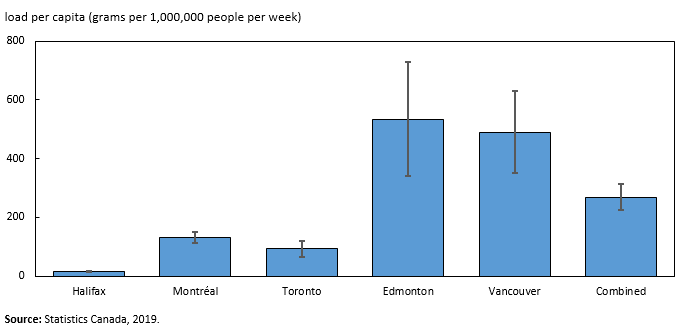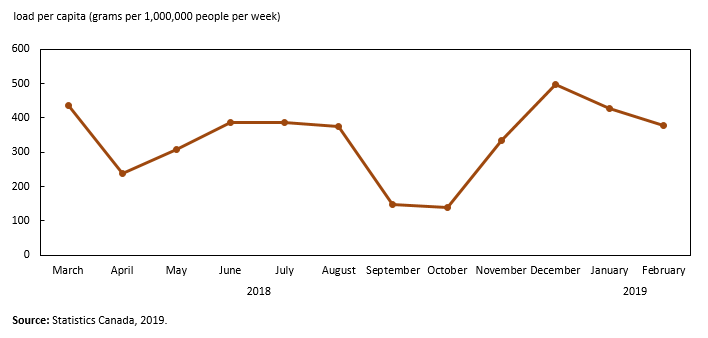In March 2018, as part of its modernization agenda, Statistics Canada launched a 12-month pilot project in five large urban centres (Halifax, Montréal, Toronto, Edmonton and Vancouver) to collect and test municipal wastewater samples at treatment plant intake for traces of cannabis and a dozen other drugs.
The combined test areas serve 8.4 million residents, or approximately 20% of the Canadian population. The test was conducted to determine the feasibility of using wastewater sampling to efficiently and anonymously measure total societal use of specific drugs, and to estimate the size of the unregulated market of such drugs.
The first phase of the pilot test yielded many lessons about how to use this potential data source, and identified key aspects requiring further refinement to improve its value. The next steps are to collaborate with experts to improve the precision of this technique, and to identify how it can be applied to other key areas of societal priority, such as infectious disease and environmental contaminants.
The pilot test results give an indication of the varied use of common drugs between Canadian cities and of seasonal variations in the use of some drugs. For example, cannabis use appeared higher in Montréal and Halifax, while Vancouver and Edmonton tended to have higher use of methamphetamine per person. Methamphetamine levels were extremely low in Halifax.
Cannabis use varies between cities
A compound called 11-nor-9-carboxy-tetrahydrocannabinol (THC-COOH) is used as a wastewater marker for cannabis consumption because it is produced by the body when cannabis is consumed. The average load of THC-COOH found in the wastewater for all sites combined was 450 grams per million people per week, but there were significant differences across the cities. Montréal and Halifax reported loads 2.5 to 3.8 times higher than Vancouver, Toronto and Edmonton.
Large spikes in THC-COOH occurred in May, June and December 2018. These spikes may result from short-term changes in the number of people consuming cannabis or in the amount consumed, or from factors related to the wastewater sampling. Further data collection and research are planned to understand the importance of each of these factors, and also whether there has been a change in total cannabis consumption since October 2018, when recreational cannabis was legalized.

Infographic 1 Cannabis metabolite load per capita by city, March 2018 to February 2019
Large methamphetamine differences across cities
Methamphetamine is an illegal stimulant. A large proportion of this drug passes through the body unchanged, so its concentration in wastewater is used as a direct indicator of consumption.
The combined methamphetamine load of the pilot sites averaged 270 grams per million people per week during the 12-month period, with no apparent seasonal variation. However, there were substantial variations in methamphetamine loads per capita across the pilot cities. Average levels in Edmonton and Vancouver were over 3.7 times higher than those in Montréal and Toronto.

Infographic 3. Methamphetamine load per capita by city, March 2018 to February 2019
While Montréal and Halifax reported the highest levels of cannabis metabolite, they had among the lowest levels of methamphetamine, suggesting that even large cities within the same country may have distinct drug-use profiles.
Methamphetamine levels in Halifax were over six times lower than in Toronto, the next-lowest city. The recorded levels are well below the observed variation in the other cities, and for other drugs. Further research will allow for comparison of these findings with other data, such as those from the justice sector and public health, vital statistics or health administrative data.
Cocaine use appears similar across test cities
Cocaine is also an illegal drug in Canada. When a person consumes cocaine, the body converts a portion of it to benzoylecgonine, a compound that is quite stable in wastewater.
The monthly loads for cocaine were more stable than for cannabis, averaging 340 grams per million people per week. The wastewater data suggest slightly higher cocaine consumption in the summer, followed by a drop in early fall, and then an increase in winter. More data will be collected to determine whether this is a regular pattern.
In contrast to THC-COOH and methamphetamine, no significant differences between cities were apparent for cocaine.

Infographic 4 Benzoylecgonine load per capita by month, March 2018 to February 2019
Wastewater-based estimates of drug consumption
The pilot test results were used to produce the first large-scale wastewater-based estimates of cannabis, methamphetamine, and cocaine consumption in Canada. Cannabis consumption was estimated at 84 tonnes across the test sites over the 12-month period, but the precision of the estimate is affected by uncertainty in the percentage of THC-COOH excreted in urine and feces after consuming cannabis. Further research to refine the excretion rate of THC and some other drugs is required to improve the quality of wastewater-based estimates of drug use.
However, the estimates produced for cocaine and methamphetamine were more precise than for cannabis. This is a positive outcome given that consumption of these drugs is expected to be underreported, because they are illegal substances. Total consumption was estimated at 370 kg for cocaine and at 310 kg for methamphetamine across the test sites.
Review of pilot test results
The pilot test results demonstrate that wastewater shows potential as a data source to measure total use of some drugs at the city level, and that it could be used, along with other data sources, to estimate total use of illicit drugs. The next phase of the research is to collaborate with other experts to improve the precision of this technique, and to identify whether it can be usefully applied in areas such as infectious disease and environmental contaminants. Advances such as these could allow this technique to provide necessary inputs to national statistical programs in a cost-effective manner, and without imposing an additional burden on Canadians.



